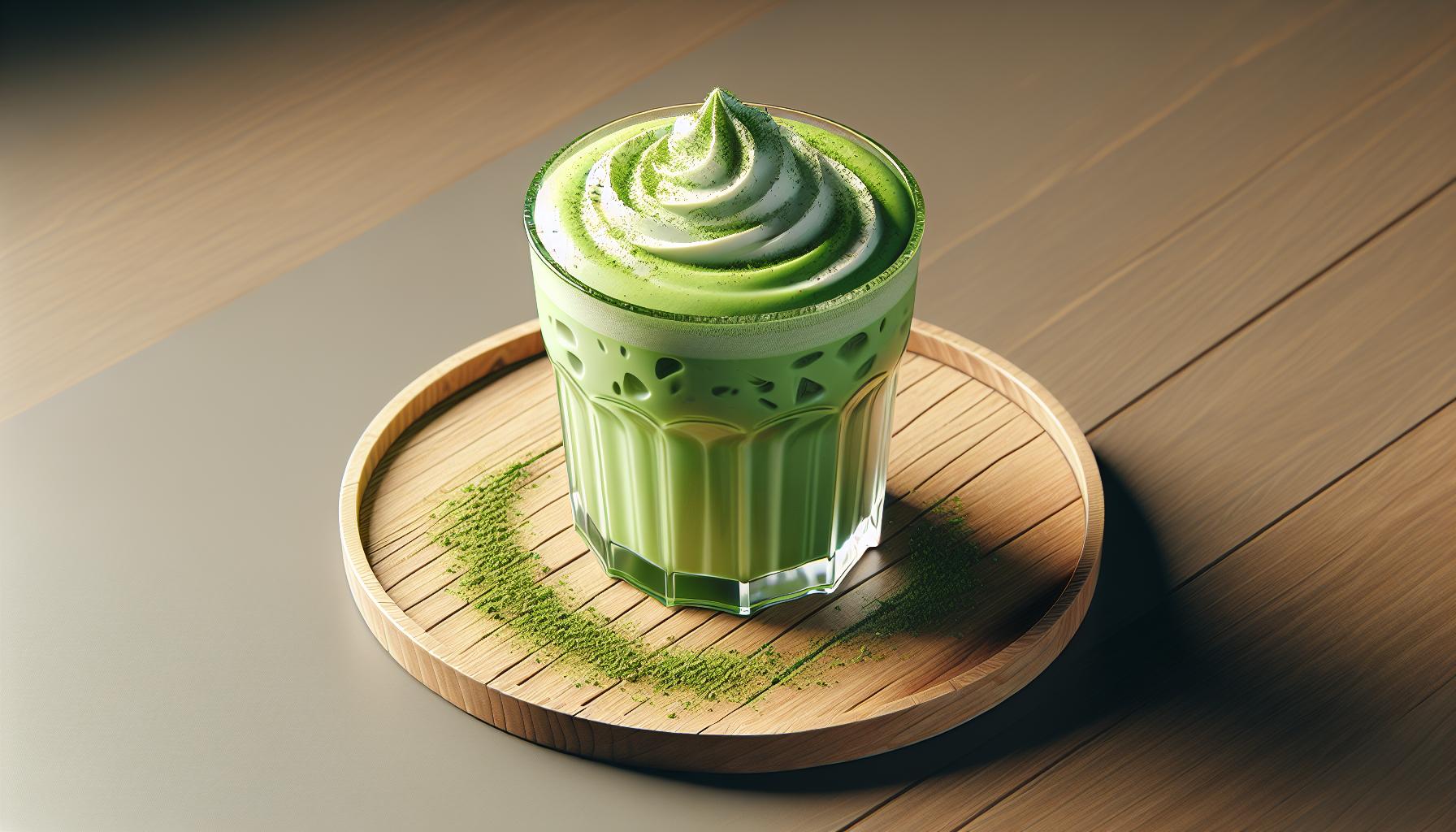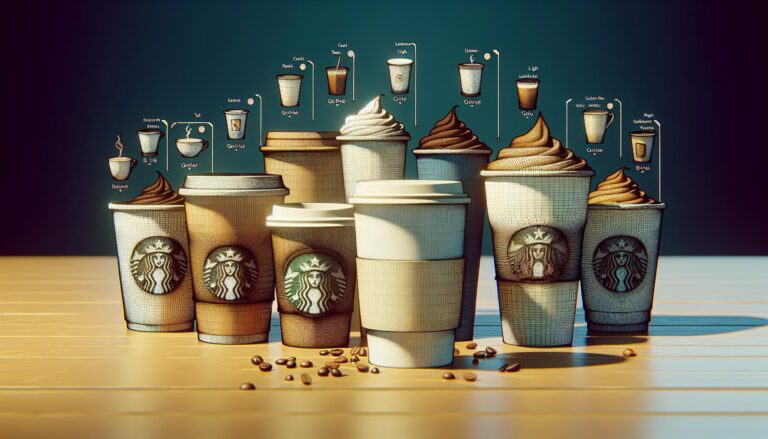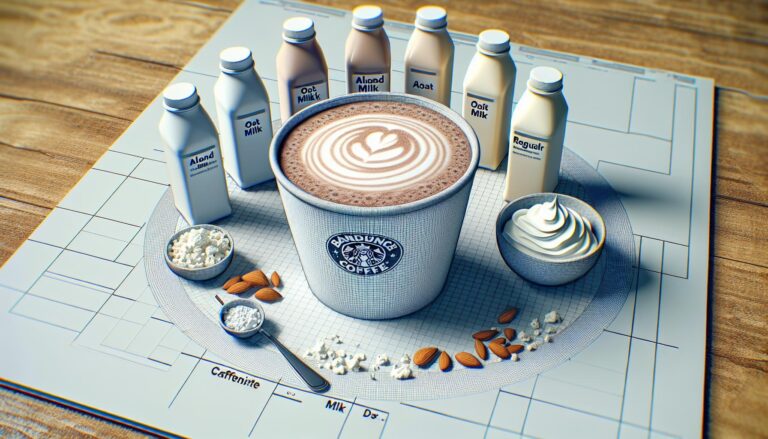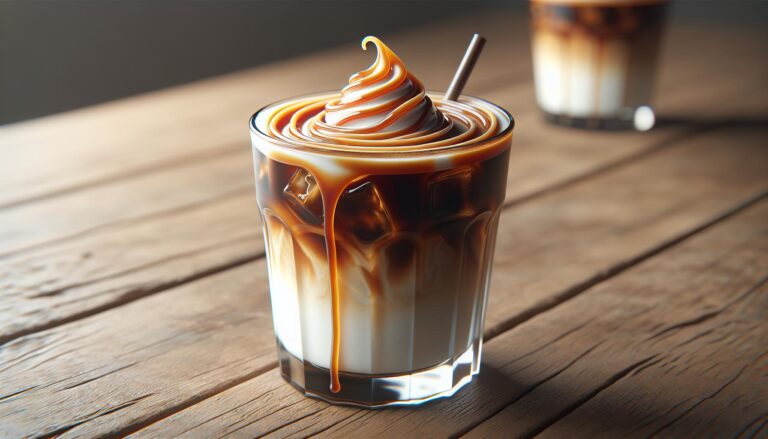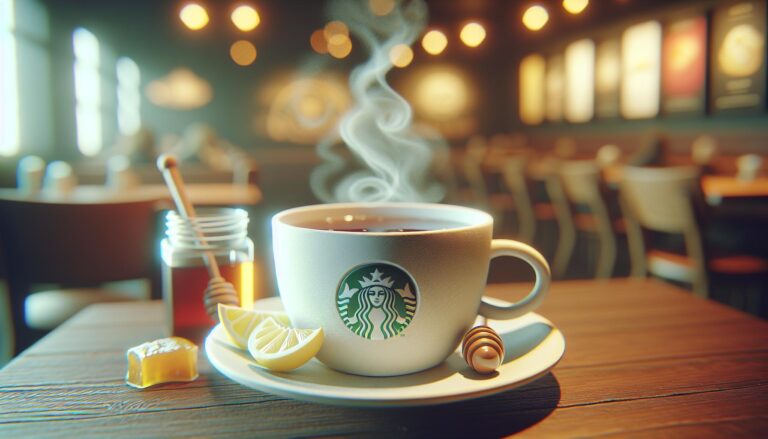Starbucks Iced Matcha Latte Caffeine Content: What You Need to Know!
How much caffeine is in the Starbucks Iced Matcha Latte? A Grande (16 fl oz) Starbucks Iced Matcha Latte contains about 80 mg of caffeine. This caffeine comes from the green tea powder, or matcha used to make the drink. The exact amount might vary a little depending on how it’s prepared.
In this article, we will explore the caffeine content of Starbucks’ popular Iced Matcha Latte.
We’ll break down how much caffeine you can expect in different sizes of this refreshing green tea-based beverage, compare it to other Starbucks drinks, and discuss some factors that influence its caffeine levels.
Key Takeaways
- Caffeine Content: A grande Starbucks iced matcha latte contains approximately 80 mg of caffeine, offering a moderate boost compared to other popular beverages like cold brew and regular coffee.
- Components: The drink comprises matcha powder, milk, ice, and a sweetener, creating a distinct taste and vibrant green color.
- Health Benefits: Matcha is rich in antioxidants and contains L-theanine, which promotes relaxation and reduces stress without causing drowsiness.
- Caffeine Effects: While moderate caffeine intake can enhance alertness, excessive consumption may lead to jitters, increased heart rate, and insomnia.
- Consumer Preferences: The iced matcha latte is popular for its unique flavor, creamy texture, and perceived health benefits, with many enjoying its customizable nature.
Overview of Starbucks Iced Matcha Latte
Starbucks Iced Matcha Latte is a popular choice for those looking to enjoy a refreshing, energizing beverage. Understanding what’s in it and its components can help you make informed drink choices.
What Is Matcha?
Matcha is a type of green tea from Japan. It’s made by grinding young tea leaves into a fine powder.
Unlike regular green tea, you consume the whole leaf in matcha, giving it more nutrients and caffeine. It’s known for its bright green color and slightly bitter taste.
- Matcha Powder: Provides the vibrant green color and distinctive taste.
- Milk: Typically regular milk, though you can opt for alternatives like almond, soy, or oat milk.
- Ice: Keeps the drink chilled and refreshing.
- Sweetener: A sweetened mix, sometimes included in the matcha powder, balances the bitterness.
Analyzing the Caffeine Content
Knowing the caffeine content in your iced matcha latte helps manage your daily intake. Let’s look at how Starbucks matcha compares to other drinks and understand its effects.
Comparing Starbucks Matcha to Other Beverages
Starbucks iced matcha latte contains matcha powder and milk, leading to its caffeine levels. A grande (16 fl oz) has about 80 mg of caffeine. Here’s a comparison with other popular drinks:
| Beverage | Size (fl oz) | Caffeine (mg) |
|---|---|---|
| Starbucks Iced Matcha Latte | 16 | 80 |
| Starbucks Cold Brew Coffee | 16 | 200 |
| Starbucks Iced Chai Latte | 16 | 95 |
| Starbucks Blonde Roast Coffee | 16 | 360 |
| Regular Green Tea | 8 | 25 |
How Caffeine Affects Your Body
Caffeine provides a temporary boost in alertness and energy. You might feel more awake after drinking caffeine because it blocks adenosine receptors in the brain. However, consuming too much caffeine can lead to jitters, increased heart rate, and insomnia.
When considering your iced matcha latte, balance your total caffeine intake throughout the day to avoid these side effects.
Health Considerations
Understanding health considerations is vital when consuming a Starbucks iced matcha latte.
Benefits of Matcha
Matcha provides several health benefits. Rich in antioxidants, matcha helps combat free radicals in the body.
These antioxidants, including catechins, support heart health. Matcha also contains L-theanine, an amino acid that promotes relaxation without drowsiness.
This helps reduce stress and anxiety. Additionally, matcha improves cognitive function, enhancing memory and concentration. Including matcha in your diet can support overall health.
Potential Concerns with Caffeine
Caffeine has its downsides. High caffeine intake can lead to jitters and insomnia. Each tall iced matcha latte contains about 80 mg of caffeine.
This amount is higher than some teas but lower than many coffee drinks. Consuming too much caffeine can also affect heart rate and blood pressure.
Pregnant women and individuals with heart conditions should monitor caffeine consumption closely. Balancing your intake can help you enjoy Starbucks iced matcha latte without adverse effects.
Also Read: Starbucks Iced White Chocolate Mocha Caffeine Content
Consumer Reviews and Preferences
Consumers rave about Starbucks’ iced matcha latte due to its distinctive taste and perceived health benefits. Let’s look into why it’s a popular choice and what frequent consumers say.
Why It’s a Popular Choice
The iced matcha latte attracts attention for its unique flavor. Matcha, made from ground green tea leaves, gives it a rich, earthy taste.
Customers appreciate its creamy texture, which comes from the combination of matcha powder and milk. Many also enjoy its vibrant green color, which adds visual appeal.
Health-conscious customers often select the iced matcha latte for its antioxidant properties. Matcha contains catechins that help fight free radicals.
The presence of L-theanine, which promotes relaxation without drowsiness, is another reason for its popularity.
Additionally, matcha offers sustained energy, making it a suitable alternative to coffee for those seeking a gentler caffeine boost.
Insights from Frequent Consumers
Frequent consumers highlight several points about the iced matcha latte. Many praise its balance of taste and health benefits.
They consider it less bitter than traditional green tea and enjoy how it pairs well with various types of milk, including almond and oat milk.
Some regulars note that it’s a versatile drink enjoyed year-round, whether it’s hot outside or chilly.
Reviews often mention the customizable nature of the drink. You can adjust sweetness levels to suit your preference, thanks to Starbucks’ range of sweeteners.
Some consumers recommend adding flavored syrups like vanilla or caramel for a personalized touch.
However, there are mixed opinions on its caffeine content. While some appreciate the moderate amount, others find it too strong or too weak depending on their usual caffeine intake.
Despite these differences, most agree that it’s a refreshing and healthy choice for matcha enthusiasts.
Understanding these consumer preferences helps in making an informed decision the next time you’re considering the iced matcha latte at Starbucks.
Also Read: Starbucks Latte Macchiato Caffeine Content
Conclusion
Choosing the Starbucks iced matcha latte can be a delightful experience, blending unique flavors with health benefits.
While its caffeine content varies, it offers sustained energy and antioxidant properties, making it a popular choice among health-conscious consumers.
Whether you’re drawn to its creamy texture or vibrant color, understanding its components and reviews can help you decide if it’s the right drink for you.
Enjoy the customization options and savor the taste, knowing you’re making an informed choice.
Frequently Asked Questions
How much caffeine is in a Starbucks iced matcha latte?
A Starbucks iced matcha latte typically contains about 80 mg of caffeine in a tall (12 oz) serving. The caffeine content can vary slightly depending on the size you choose.
What are the main components of the iced matcha latte?
The primary ingredients in a Starbucks iced matcha latte are matcha green tea powder, milk, and ice. Some versions may include added sweetener or syrups for enhanced flavor.
What are the health benefits of matcha in the iced matcha latte?
Matcha is rich in antioxidants, particularly catechins, which help fight free radicals. It also contains L-theanine, an amino acid known for promoting relaxation without drowsiness and providing sustained energy.
Why do health-conscious consumers prefer the iced matcha latte?
Health-conscious consumers often choose the iced matcha latte for its antioxidant properties, which help support overall health. Additionally, it provides sustained energy without the jitters commonly associated with coffee.
How do consumers generally feel about the taste of the iced matcha latte?
Many consumers appreciate the iced matcha latte for its unique earthy flavor, creamy texture, and vibrant green color. It has grown in popularity thanks to these distinct characteristics and customizable options.
Can the caffeine content in the iced matcha latte be adjusted?
Yes, the caffeine content can be adjusted by changing the number of scoops of matcha powder or opting for different drink sizes. Customization allows for a more personalized caffeine intake.
Are there any potential drawbacks to drinking the iced matcha latte?
Some consumers find the caffeine content of the iced matcha latte either too high or too low, depending on their tolerance and personal preferences. However, this can usually be adjusted to suit individual needs.

